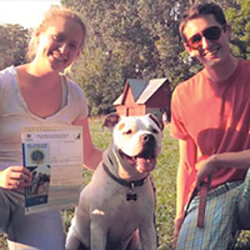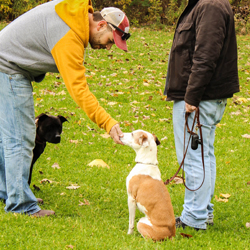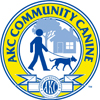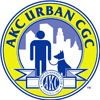

The AKC's Canine Good Citizen© (CGC) program stresses responsible pet ownership for owners and basic good manners for dogs, and is recognized more and more as the standard for "good dogs". Many businesses and landlords require dogs to be certified, and CGC tests are often used as a benchmark for other advanced training and work including therapy dogs. All dogs who pass the 10-step test may receive a certificate from the AKC recognizing your dog who responds to basic commands and is under good control in a social setting. There are now three levels of CGC titles to achieve.
Tests can be taken at any age, but we recommend at least a year old. Once your dog passes the standard CGC, you may opt to test for either or both Community Canine and Urban Canine tests. Any dog may obtain a certificate from the AKC upon passing. Dogs can also earn a CGC title, but must be registered with one of the following: 1) AKC number, 2) Purebred Alternative Listing number (PAL), or 3) AKC Canine Partners number (for mixed-breed dogs). Visit the AKC's web site for more info.
Tests take approximately a half hour. The standard CGC and Community Canine tests are scheduled at our class locations and take about a half hour ($40). The Urban Canine test is scheduled at another predetermined location ($75).
Our training programs can help you practice the obedience and socialization skills needed to pass any level of CGC. See our Canine Good Citizen® Prep class offered to Pack Members, or contact us about private training options.
CGC Test Levels
- Accepting a friendly stranger—a friendly stranger approaches and speaks in a natural, everyday situation.
- Sitting politely for petting—The dog will allow a friendly stranger to pet it while it is out with its handler.
- Appearance and grooming—checking the dog's ears and front feet, as a groomer or veterinarian would do.
- Out for a walk—walking on a loose lead.
- Walking through a crowd—Dog and handler walk around and pass close to at least 3 people.
- Sit and down on command and staying in place—owner choose sit or down for the stay.
- Coming when called—handler calls dog to come from 10 feet on a leash.
- Reaction to another dog—Another handler and dog approaches from a distance, stops, shake hands, talks.
- Reaction to distraction—Sudden noises, items being dropped, etc.
- Supervised separation—owner leaves dog with an unfamiliar person for 3 minutes.
- Dog stands, sits or lies down and waits under control while the owner sits and fills out paperwork.
- Walks on a loose leash in a natural situation—does not pull.
- Walks on loose leash through a larger crowd.
- Dog walks past distraction dogs present; does not pull.
- Sit, stay in small group while owners have a conversation. Dogs are all on the owner's left side, on leash; 3 ft. apart.
- Dog allows person who is carrying something (backpack, computer bag, etc.) to approach and pet it.
- "Leave it." Dog walks by food and follows owner instructions, "Leave it."
- Down or sit stay at distance. On 20 ft line, owner walks away with back to dog, picks up an item and returns to dog.
- Recall with distractions present. Handler goes out 20 ft. and calls dog.
- Sit or stand stay while owner enters/exits a doorway or narrow passageway. Owner calls dog through door when ready.
- Exit/enter doorway with no pulling in dog-friendly buildings.
- Walk through a crowd on a busy urban sidewalk.
- Appropriate reaction to city distractions. This includes movement, noises, and walking on a variety of surfaces.
- Crossing street: Stop at corner, stand or sit to wait and cross with no pulling (on leash, with owner).
- Ignore food on sidewalk.
- Person walks up and pets the dog.
- Walks under control in public building. Down stay in lobby or outdoor area, or waits while owner has a meal or snack.
- Stairs, steps, or elevator under control.
- Housetrained for apartment, condo, city living.
- Enters/exits, remains under control during the ride in chosen mode of transportation.




